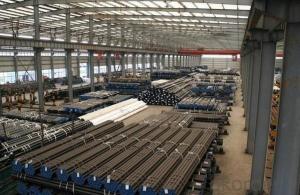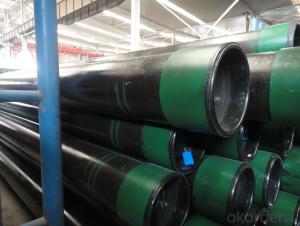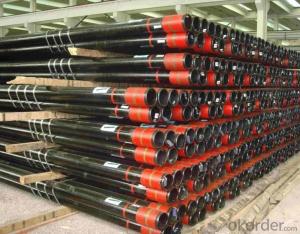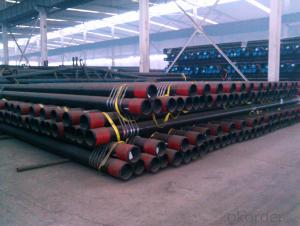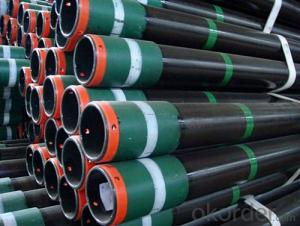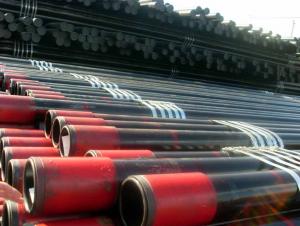API 5CT J55 K55 N80 L80 P110 casing pipe and tubing
- Loading Port:
- Tianjin
- Payment Terms:
- TT OR LC
- Min Order Qty:
- 10 m.t.
- Supply Capability:
- 100000 m.t./month
OKorder Service Pledge
Quality Product, Order Online Tracking, Timely Delivery
OKorder Financial Service
Credit Rating, Credit Services, Credit Purchasing
You Might Also Like
Specifications
1.Standard: API 5CT-0735 & ISO9001:2008
2.Specifcation: 4 1/2"- 20"
3.OD: 114.30 - 508 mm
4.WT: 5.21 -13.06 mm
API 5CT Casing pipe and Tubing:
Steel grade: J55 K55 N80-1 N80-Q L80 P110
Size: Tubing 2 3/8" - 4 1/2"
Casing pipe 4 1/2"-20"
Certification: API 5CT
Length: R1(4.88-7.62M) R2(7.62-10.36M) R3(10.36-14.63M)
Thread type: BTC LC SC
- Q: What are the safety regulations for working with steel pipes?
- The safety regulations for working with steel pipes may vary depending on the specific circumstances and location, but some common safety measures include wearing appropriate personal protective equipment (PPE) such as gloves, safety glasses, and steel-toed boots, ensuring proper handling techniques to prevent injuries, using proper lifting equipment to prevent strain or back injuries, implementing proper ventilation and respiratory protection when working in confined or poorly ventilated spaces, and following proper procedures for welding, cutting, or bending steel pipes to minimize the risk of fire or explosions. It is essential to consult and adhere to local safety regulations and guidelines to ensure a safe working environment when dealing with steel pipes.
- Q: How do you prevent steel pipes from rusting?
- To prevent steel pipes from rusting, various measures can be taken. One effective method is to apply a protective coating on the surface of the pipes. This can be done using different types of coatings such as paint, epoxy, or zinc. These coatings act as a barrier between the steel and the corrosive environment, preventing moisture and oxygen from coming into direct contact with the metal and causing rust. Another approach is to use corrosion inhibitors. These substances are added to the water or fluid flowing through the pipes to create a protective film on the steel's surface. This film acts as a shield, inhibiting the corrosion process and preventing rust formation. Regular maintenance is crucial in preventing rust on steel pipes. This includes inspecting the pipes for any signs of damage or corrosion and promptly repairing or replacing any compromised areas. Additionally, keeping the pipes clean and dry by removing any accumulated dirt or moisture helps to prevent rust formation. In some cases, it may be beneficial to use stainless steel pipes instead of regular steel. Stainless steel contains chromium, which forms a passive oxide layer on the surface of the metal. This layer acts as a natural barrier against corrosion, making stainless steel pipes highly resistant to rust. Lastly, controlling the environment in which the pipes are installed can also help prevent rust. This can be achieved by maintaining proper ventilation, controlling humidity levels, and avoiding exposure to harsh chemicals or corrosive substances. By implementing these preventive measures, the lifespan and integrity of steel pipes can be significantly extended while minimizing the risk of rust formation.
- Q: How do you prevent freezing in steel pipes during cold weather?
- To avoid freezing in steel pipes during cold weather, there are various steps that can be taken: 1. Insulating the pipes proves effective in safeguarding them from freezing. Utilize insulation sleeves or wraps to cover the pipes, especially in areas where they are exposed to low temperatures. Insulation aids in retaining heat and preventing the pipes from reaching freezing temperatures. 2. Identify and seal any air leaks around the pipes that allow cold air to enter. Use caulking or weatherstripping to seal these gaps and prevent the pipes from being exposed to cold air. 3. It is important to maintain a consistent temperature in the vicinity of the pipes. Ensure that the area is adequately heated and insulated. This will help keep the temperature above freezing and prevent the pipes from freezing. In extremely low temperatures, consider utilizing heat tape or pipe heating cables to provide additional warmth. 4. Allowing a small, continuous trickle of water to flow through the pipes can help prevent freezing. The flowing water generates heat and inhibits the formation of ice within the pipes. However, this method should only be used as a last resort due to potential water wastage. 5. If the steel pipes are located in an area that is not regularly used or if freezing weather is anticipated, it may be advisable to completely drain the pipes. Turn off the water supply and open all faucets to allow the water to drain out. This eliminates any standing water that could freeze and potentially cause the pipes to burst. It is crucial to note that prevention is key, as frozen steel pipes can result in expensive damages and water leaks. By implementing these measures, you can safeguard your steel pipes and ensure their functionality during cold weather.
- Q: D108*4 what does "D108" mean by seamless steel tubes? What does "*4" mean?
- D108: refers to the outer diameter of 108mm;4: refers to the wall thickness of 4mm.
- Q: What's the gate number of the precision steel pipe?
- This kind of steel tube and ordinary hot-rolled seamless steel pipe and cold drawn seamless steel tube in the outer surface is different from the outer surface, and the diameter of the smooth finish of precision steel tube, stainless steel color and the same, inside and outside surface due to manufacturing reasons with a layer of oil.
- Q: What are the different types of gaskets used with steel pipes?
- There are several types of gaskets commonly used with steel pipes, including ring type joint (RTJ) gaskets, spiral wound gaskets, and flat gaskets. RTJ gaskets are designed to create a tight seal by compressing between two flanges, while spiral wound gaskets consist of a metal winding and filler material for enhanced sealing properties. Flat gaskets are typically made from rubber or non-metallic materials and are used for lower pressure applications.
- Q: What are the different coatings applied to steel pipes?
- There are several different coatings applied to steel pipes, including epoxy coatings, polyethylene coatings, zinc coatings (galvanization), and fusion bonded epoxy coatings. These coatings are used to protect the steel pipes from corrosion, increase their durability, and improve their performance in various environments.
- Q: Are there specifications for scaffold steel pipe with 48mm * 3.2mm?
- However, there are a variety of non GB steel tubes on the market, mainly in the wall thickness, and are thinner than the national standard requirements, you said that thickness may have, but the thinnest only about 2.6mm-2.7mm.
- Q: What place must use galvanized steel pipe to make lighting line?
- Galvanized steel is widely used in construction, machinery, coal, chemical industry, railway vehicles, automobile industry, highway, bridge, container, sports facilities, agricultural machinery, petroleum machinery, prospecting machinery and other manufacturing industries.
- Q: What does "buried steel pipe" 6*2SC100 mean?
- The embedded steel pipe 6*2SC100 refers to a welded steel pipe with 2 pipe thicknesses of 6mm and a diameter of 100mm. SC pipe means welded steel pipe. Embedment means pre installation (burial).
Send your message to us
API 5CT J55 K55 N80 L80 P110 casing pipe and tubing
- Loading Port:
- Tianjin
- Payment Terms:
- TT OR LC
- Min Order Qty:
- 10 m.t.
- Supply Capability:
- 100000 m.t./month
OKorder Service Pledge
Quality Product, Order Online Tracking, Timely Delivery
OKorder Financial Service
Credit Rating, Credit Services, Credit Purchasing
Similar products
Hot products
Hot Searches
Related keywords



















